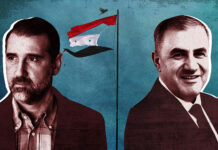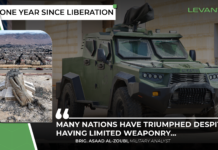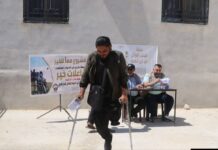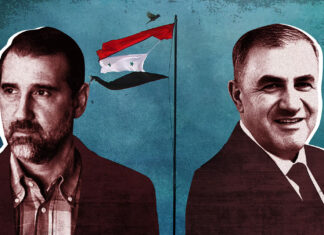
Nestled in the province of Idlib in northwestern Syria, Ariha is a town steeped in history. A city described in the annals of history as “the most verdant and luscious on God’s earth” holds immense geographical and regional significance. Historically, it has been a critical juncture for trade and cultural exchange, connecting the coastal region of Latakia with the inland cities of Aleppo and Idlib. Geographically, Ariha’s position on the northern slope of Jabal Arbaeen offers a high vantage point, making it a key military asset. The city’s control has long been a contentious issue, influencing the broader dynamics of power and territorial control throughout the years of the Syrian revolution. Its liberation by Jaish al-Fatah nine years ago on May 25 2015 represents a pivotal moment in the struggle for dominance in this war-torn region
Its liberation was a turning point in the protracted Syrian conflict which had far-reaching implications for territorial control and the balance of power in the area. Its capture not only disrupted regime supply lines but also strengthened the revolutionary foothold in northwestern Syria and was a great victory in terms of its symbolic power, both striking a devastating psychological blow to Assad and his allies as well as bolstering the spirits and morale of the free people of Syria and the revolution.
A Lofty City
Ariha’s importance cannot be overstated. As a key urban center, it serves as a critical junction linking the coastal region of Latakia with Aleppo and Idlib. This connectivity is vital for both logistical support and movement of troops. By liberating Ariha, revolutionary forces effectively cut off a significant supply route for the Assad regime, isolating Latakia from Aleppo and Idlib. This disruption has had a domino effect on the regime’s ability to maintain control over northern territories.
“Ariha holds significant military importance, not least because of its surroundings, which include Jabal Arbaeen. The region is strategically positioned, revealing many cities, towns, and villages, especially Idlib,” Hassan al-Shami, a commander with Fath al-Mubin and veteran of the battles to liberate the city told L24. “Ariha serves as the gateway to Jabal Zawiya, which holds great importance and is symbolic for the revolutionaries in Idlib and its surroundings. Its liberation paved the way for many subsequent victories against the criminal Assad regime.”

The capture of Ariha served as a great rallying point for the revolutionary forces, and its impact on the morale and spirit of the people in the region cannot be overstated. It demonstrated their ability to launch coordinated offensives and hold strategic positions, challenging the domestic and international narrative of regime invincibility. As al-Shami explained, “The morale factor was crucial in this regard. The liberation of the city of Ariha, with its known significance and strategic location, had a positive effect on the fighters of Jaish al-Fatah and the Syrian revolutionaries, while it had a negative effect on the Assad gangs, who began to withdraw rapidly from the areas.”
This victory galvanized support from local populations and international backers, further bolstering the revolutionaries’ capacity to sustain their fight. The capture of the city and its high vantage point also helped pave the way for the liberation of other cities and areas, “the regime lost artillery positions and rocket launchers that provided coverage over vast areas, undermining their firepower density in the region. This led to the liberation of major cities in the province such as Jisr al-Shughur and other villages. The liberation of Ariha is considered a significant point in the battle for the province, as it serves as the center of the Ariha region and the capital of Jabal Zawiya.”
A Hard-won Victory
“The most significant challenge was the presence of civilians within the city during the battle for its liberation. This posed an additional burden on the fighters of Jaish al-Fatah, while Assad saw it as an opportunity and military asset, as they were spared from intensive bombardment and other military tactics,” explained Hassan al-Shami. “Additionally, the mountainous nature of the area contributed to the battle’s difficulty, as the regime-controlled naturally fortified highlands and locations. However, the fighters managed to find ways to surprise the enemy, leading to their quick retreat from the city within hours.”
Osama Jaqmour, an activist from Ariha who spoke with L24, detailed the hardships facing the civilians during the fight to free the city, “As for the challenges the city faced during liberation, they were primarily military challenges. Dealing with a criminal regime that didn’t hesitate to spill civilian blood, committees were formed, tasks were distributed among them, and coordination between the revolutionaries (and the people) was established to avoid civilian causalities during the battle.”

“Plans were made,” continues Jaqmour, “tasks were divided between evacuation routes, ambulance and medical routes, and food supply lines. The city was located on the northern slope of Jabal Arabeen, and with the regime forces stationed on the peaks and besieging the city, the revolutionaries anticipated that the battle wouldn’t be easy. The regime, as usual, would use civilians as human shields and wouldn’t hesitate to bombard the liberated neighborhoods. However, by the Grace of God, most of these preparations proved unnecessary except for the evacuation teams.” This was because the regime and its militias quickly fled at the start of the battle, which, Jaqmour notes, spared civilians from many dangers.
After Occupation: Rebuilding and Hope
Today, a liberated Ariha plays a crucial role in the broader landscape of the liberated areas. It functions as a vital hub for humanitarian aid and civilian governance. The city has become a symbol of resistance and resilience, embodying the aspirations of the Syrian revolution.
“As for the liberation of the city of Ariha, it had a significant impact on the community, similar to other areas liberated from the regime’s grip. During its occupation, Ariha was an isolated area suffering from the security dominance of Iranian militias, Assad, and Hezbollah. Its inhabitants did not feel safe even in their own homes,” said Jaqmour. The days of occupation were what Jaqmour described as days of terror where repression and fear were the norm, homes were raided in the middle of the night and civilians were attacked at will, the regime and its allies reduced “society into something akin to a jungle.”

The liberation of Ariha not only brought immediate relief to its residents but also marked the beginning of a challenging yet hopeful rebuilding process. The city’s transformation from a site of conflict to a center of civil governance and community resilience is a testament to the revolutionary forces’ commitment to fostering stability and progress in liberated areas.
“From the first day of liberation,” Jaqmour recalls, “despite their initial action of fleeing the city fearing its targeting, joy appeared on the faces of the locals. … Upon liberation, the remaining people breathed a sigh of relief, and hope for life began to emerge.”
Moreover, the city’s liberation has facilitated the establishment of local councils and civil society organizations, which are crucial for maintaining order and addressing the needs of the population. These institutions worked to rebuild infrastructure, provide education, and support economic activities, contributing to a sense of community and hope for a future free from conflict.

“After these years of liberation, the significant changes that occurred in the local community became evident. The city flourished, its markets organized, and services improved significantly. Facilities developed greatly, and a generation grew up cherishing freedom.”
However nothing is perfect, and Jaqmour acknowledges there is still much work to be done in a land still in the throes of a 13-year-long war, commenting on the region, “[We] face greater challenges, as factional rule and conflicts hinder progress in administrative and service fields. Ariha is considered a neglected city that hasn’t received its fair share of attention on all levels. It remains a target for regime attacks. The city’s sons and activists continuously strive to provide solutions to the city’s problems, albeit with very slow progress.”
A Blueprint for Future Success
The success in Ariha serves as a blueprint for coordinated military efforts and civilian governance in liberated areas, demonstrating the potential for a future where Syrians can determine their own destiny. The city’s liberation nine years ago represents a critical juncture in the Syrian struggle for freedom and dignity. Its strategic significance and ongoing role in the fabric of the liberated areas show the resilience and determination of the Syrian revolutionary forces and the civilian population. As the conflict continues, Ariha stands as a beacon of hope and a testament to the enduring spirit of the Syrian people.
While the road is still long and the city remains firmly in the cross-hairs of the criminal regime Jaqmour remains hopeful, “Ariha endured a large share of the crimes of the Assad regime and its allies, witnessing horrendous massacres that still haunt the conscience. The shells of hatred continue to rain down on the city to this day, but faith in Allah and love for life surpass all the means of crime they pursue.”








